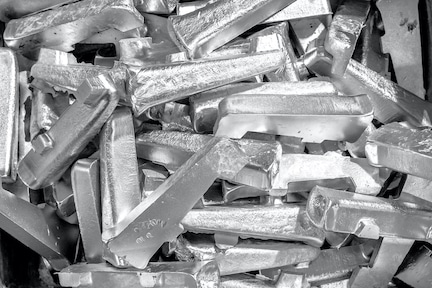The word platinum sometimes enjoys a cache higher than even gold, as platinum albums and platinum credit cards attest. However, widespread knowledge of the white metal stretches back only a few hundred years, versus thousands for gold. Despite being worked with some skill by South American Indians over 1,000 years ago, it was not until after the Spanish conquest of the New World during the fifteenth and sixteenth centuries that news reached Europe of new white metal with unusual properties.
By the end of the 17th century, Spanish Conquistadors had discovered alluvial deposits of platinum while they were panning for gold in the Choco region which is today Colombia. They considered the metal a nuisance because it interfered with their gold mining activities. In fact, since platinum was considered of little value, it was soon being used by forgers to adulterate Spanish gold coins.
Despite its extreme rarity, platinum’s extraordinary properties made it of interest to European scientists. Upon its introduction to Europe, platinum was noted as a substance that could not “melt by fire or by any of the Spanish arts.” It was known to be even heavier than gold and to be virtually impossible to corrode with gases or chemicals. These properties piqued the interest of a Swedish assayer named Scheffer who, in 1751, recognized platinum as the seventh element known to exist up until that time. He was also the first to successfully melt platinum.
Early Industrial Use
During the rest of the eighteenth century, platinum’s star rose quickly. The very qualities that had, for centuries, made platinum difficult to work, now made it attractive for industrial uses. For example, platinum was used to make laboratory instruments in Berlin in 1784. In 1780, it was being used in France to make crucibles for glass production, a use that consumes tens of thousands of ounces of platinum each year.
1700’s
As new industrial uses for the metal were discovered, platinum’s tarnishless beauty and strength also began to impress jewelers and goldsmiths. In 1788, Francisco Alonso of Spain crafted a platinum chalice, weighing nearly two kilograms, for Pope Pius VI. Other leading metalworkers such as Marc Janety, Royal Goldsmith to Louis XVI, and Pierre Chabaneu, of Spain, were also enchanted with platinum. Soon, platinum was being used to make expensive cutlery, watch-chains, and coat buttons.
1800’s
Early in the 19th century, new refining techniques increased platinum’s availability for use in a growing number of industries. As more platinum became available, it was soon being used in gun parts, sophisticated batteries, and fuel cells, the production of caustic chemicals (the first platinum sulphuric boiler weighed over 400 ounces), and the purification of hydrogen.
One constant problem preventing the even more rapid spread of platinum use was its extremely limited supply. In fact, in 1820, Colombia, still the only major producer of platinum in the world, ceased exporting the metal due to the nation’s independence from Spain. Luckily for the growing platinum industry, a new supplier was soon found: Russia.
In 1822, alluvial platinum was proved to be present in the goldfields of the Ural Mountains along with osmium, rhodium, iridium, and ruthenium. Since there was little demand for platinum in Russia for jewelry, industrial or scientific use, and still only modest amounts were needed abroad, the Russian government decided to make platinum into a monetary metal by producing platinum roubles. Over the next 18 years, the Russian government minted almost 500,000 ounces of platinum and, perhaps more importantly, introduced to the world the notion that platinum was not just a commodity, but was also, like gold, a store of value.

Being stronger and more durable than gold, platinum jewelry is less likely to break and can last longer.
Jewelry
While industry and bullion coinage were major consumers of platinum in the 19th century, platinum jewelry remained rare until high-temperature jewelers’ torches were developed later. Once this development was made, jewelry makers were quick to take advantage of platinum. Before the first decade of this century, the whiteness of diamonds had long been highlighted by setting them in silver. However, silver’s relative softness meant that these settings had to be relatively heavy, taking away some of the brilliance of the stone. Thus, as jewelers became more adept at using “the other white metal,” platinum quickly took over the role of the diamond setting of choice.
The Modern Commodity
The number and scope of platinum’s industrial uses have skyrocketed during this century to include neurosurgical and dental apparatus, drugs for cancer treatment, computers, and electrons for automotive equipment. Indeed, one of every five goods manufactured either contains or is produced using platinum, which can be dissolved in aqua regia that is a combination of hydrochloric and nitric acid and cannot tarnish. One of its most essential uses is in autocatalytic converters without oxidation. Within autocatalysts, platinum converts harmful emissions into carbon dioxide and water. Nearly one-third of newly mined platinum is used in this fashion. Due to its function in the automotive industry, it has been dubbed “the environmental metal.”
While new uses for platinum are being discovered almost daily, its supply is extremely restricted. Remarkable difficulties exist in its mining and production, with between 5 and 6 million ounces of new platinum reaching the world market each year; that figure is less than 5% of gold production. It is estimated that all of the platinum ever mined would fill a room measuring less than twenty-five feet on a side. Refining the metal poses its own problems. Platinum occurs naturally in combination with other metals, necessitating an intricate process of extraction that takes about six months.
Limited Sources
This problem is exacerbated by the limited sources of platinum production. The world’s growing appetite for platinum is essentially satisfied by the mining activities in just two regions. The Bushveld Complex, which is just north of South Africa’s capital, Pretoria, is one. The mines in this area produce more than two-thirds of the platinum that reaches the markets each year. The other site is in the Norilsk-Talnakh region in the extreme north of Siberia in Russia. It is estimated that at least one-quarter of the world’s supply is either currently mined here or is from above-ground stocks that were accumulated over many years. Russia is the only nation with significant stocks of platinum and it is believed that these may be running out, mixed with cooperite which consists of platinum sulfide and various impurities.
Platinum’s relative scarcity in the face of newly discovered and ever-increasing uses makes for an attractive 21st-century investment. Platinum’s historical price performance and its unique fundamentals are attracting an increasing number of informed investors. Precious metals have long been recognized for their tendency to appreciate when other financial instruments, like stocks and bonds, are declining. Investors, however, are not content with simply “securing” their assets against inflation and other economic dangers. They also demand the opportunity for capital appreciation. Platinum’s unique fundamentals offer investors both. The ability to hedge against uncertainty and the potential for profit.
Platinum’s supply/demand fundamentals are tight. In fact, according to some estimates, were platinum mining to cease today as a ductile by-product, above ground reserves, would last about one year. In contrast, gold reserves would last nearly one-quarter of a century. Platinum’s supply is tight even during periods of relatively normal mining production. Enough platinum was supplied to world markets last year only after Russia exported considerable amounts of platinum from its above-ground reserves. Although Russia introduced platinum coinage over 150 years ago, investors had to wait until the second half of the last century before they could easily invest in platinum from the periodic table.
Platinum Futures
In 1956, the New York Mercantile Exchange introduced platinum futures as a way to diversify from its exclusively agricultural offerings. While futures offered a standard and liquid outlet, the highly leveraged nature of futures trading meant that individual investors faced a high risk of losing a large share of their investment due to small changes in the price of the underlying commodity. As a consequence, most platinum futures contracts are today held by industrial hedgers or major speculators.
Platinum Bullion
In 1975, after the Arab Oil Embargo and the collapse of the Bretton-Woods agreement sparked increases in precious metals prices, Tanaka Kikinzoku Kogyo KK, the leading bullion house in Japan, introduced platinum bars that were small enough for the individual investor to buy. With platinum close to $180 per ounce, Tanaka’s five-gram and ten-gram bars could be bought by investors for well under $100. That platinum bullion investments were first introduced in Japan made perfect sense because platinum jewelry was already highly popular there.
With platinum’s huge price changes during the 1970s and early 1980s interest in platinum bullion investing spread to Europe and the United States. Two platinum fabricators, Johnson Matthey & Co. Ltd., and Engelhard Corporation began to produce one and ten-ounce platinum bars. Soon thereafter, the variety of platinum bullion bars rose as JM, Engelhard and Tanaka expanded their lines, and firms like Degussa jumped into the market.
Platinum Coins
In November of 1983, platinum investing entered a new era when, for the first time, a nation began to issue platinum legal tender coins that derived their value almost entirely from the platinum. The Isle of Man, a British Crown Possession, issued a one-ounce Noble. Legal tender bullion coins are viewed by many as the most secure way to own platinum. Most importantly, they are not subject to assay because their weight and purity are backed by the nation. They are also portable, liquid, and often quite beautiful.
The Isle of Man’s highly successful Noble enticed other mints to issue their own platinum coins. During the second half of 1988, Australia (the Koala) and Canada (the Maple Leaf) introduced platinum legal tender bullion coins within three months of each other. Despite the proximity of the launches, both introductions were enormously successful, bringing the level of investment demand to new highs.
For nearly ten years, Australia’s Koala and Canada’s Maple Leaf were among the leading platinum coins in annual sales. In addition to these programs, the 1990s witnessed the release of dozens of limited edition platinum proof coins to satisfy numismatic demand. These products derive their value from both the price of the platinum they contain and from collector demand for the individual issues. China, for example, issued a coin in a number of weights called the Panda.
While the Panda is popular with collectors its beautiful design has also made it the center of many jewelry pieces. Another recent introduction was Russia’s Ballerina proof coin. In fact, during the past decade, Russia (and the former USSR) released at least 18 different platinum legal tender coin designs. The Isle of Man has also been active in the platinum numismatic market. Besides its bullion coin, The Isle of Man has minted roughly three dozen unique platinum coin designs since 1979.

The American Platinum Eagle is the official platinum bullion coin of the United States.
Enter the Eagle
In 1997, the United States Mint launched its first platinum bullion coin, The Platinum American Eagle. The launch of the Platinum Eagle brought a near doubling in investment demand from 1996 levels. The Platinum Eagle quickly became the most popular platinum coin in the world with the bullion fractionals selling at premiums to their original cost owing to the relative scarcity and popularity of the coins.
The Proof Platinum American Eagles experienced such heavy demand when first released that many denominations sold out completely. Being “first” in many categories, collectors have been willing to pay premiums on the secondary market for the Platinum American Eagle. The Vistas of Liberty series started in 1998, featured on the Platinum Eagles in five different regions of the United States, with the program running through the year 2005. No coins like these can ever be struck again - and collectors have responded accordingly.
So after 100 years of no investment options, the platinum investor now can choose between legal tender coins, bullion bars, exchange-traded futures, and options, or even various numismatic coin products. However, while the development of platinum as an industrial, jewelry and investment product has been an interesting one, the white metal’s most exciting advances may lie ahead. As trade barriers have fallen and command economies have been privatized, we have seen the acceleration of economic growth throughout the world. What makes this so exciting for platinum investors is that, in contrast with gold and silver, as countries become wealthier, they spend an increasing share of their wealth on platinum. This phenomenon is most clearly seen in the recent rapid spread of catalytic converter legislation to many emerging markets that, therefore, consumed only insignificant amounts of platinum but now view it as corrosion-free.
From being the metal that polluted the gold of the Conquistadors to its recognition as being the rarest or even the most precious of the precious metals, platinum’s odyssey has given it the investment performance of a precious metals hedge with the potential of the scarcest of industrial commodities.
Platinum Processes and Uses
Nuggets or grains of pure platinum can be found in nature with atomic weight and isotopes, but more frequently, platinum is found alloyed with other metals, such as iron, copper, gold, nickel, and the other platinum group metals or PGMs. The size of platinum grains or nuggets varies from small granules to pebbles weighing up to 20 pounds (9 kg) or more. When platinum is found in a pure state, it is called native platinum.
In contrast to gold, platinum nuggets are relatively inconspicuous. They have a dull grayish or blackish color but when you handle them, they can be distinguished by their extraordinary heft. When iron is present in the alloy, a platinum nugget can also be slightly magnetic, a diagnostic tool for evaluating new discoveries, and useful as electrodes, electrical contacts with a high melting point.
Early Platinum Mining
Native platinum and platinum group metals alloys can be found in concentrated sand and gravel beds called placer deposits in the earth's crust. The sand and gravel beds are created when old rock is eroded from its source and further ground into pieces as it is washed into streams and rivers. Most of the world’s placer platinum is found in Russia. In the 19th century, alluvial deposits in the Ural Mountains were heavily mined. However, these deposits have been stripped of their highest-grade ore and now account for less than one percent of the platinum production from Russia.
Modern Platinum Mining Techniques
Most of the mining for platinum ore occurs deep underground. To extract the mineral-rich materials, miners pack explosives into holes drilled in the rock and blast it into smaller pieces. The broken rock is then collected and transported to the surface for processing.
Refining platinum ore is a costly and laborious process of the rare metal. It can take from eight weeks to six months to process a batch of ore, and it can take up to 12 tons of ore to produce a single troy ounce of platinum. Once the broken ore is transported to the surface of the mine, it is crushed by machinery into small pieces and mixed with water and chemicals, which bind to the platinum and other metals.
Conclusion
Platinum deposits are located in only a few areas of the world. For every ten gold mines, there is only a single platinum mine. All the platinum ever mined would fill a room no more than 25 feet square. Today, world platinum production hovers at about seven million troy ounces a year.
More than 70 percent of the world’s platinum supply comes from the Bushveld Complex in South Africa’s Transvaal. Platinum was discovered in this region in 1924, further fueling the world’s platinum craze.
Russia is the second-largest producer of platinum. The Norilsk-Talnakh region of Siberia contributes 20 percent of the world’s platinum supply, which is retrieved from massive nickel-copper-palladium deposits some 1200 meters below the surface. Another six percent of the world’s supply comes from the USA, where large deposits can be found in Montana, Alaska, and Ontario, Canada, South America, and Zimbabwe.




